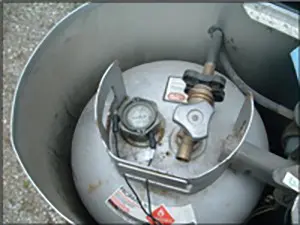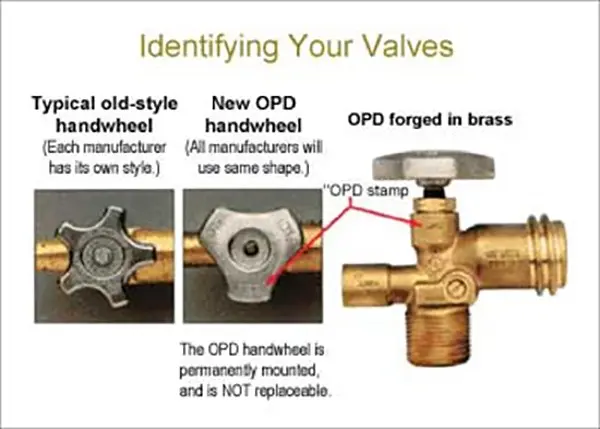Propane is a safe, clean burning and efficient fuel, but it must be handled properly and safely. Please read and follow these safety guidelines and share them with your family to help keep everyone safe and to reduce the risk of serious and potentially fatal injury, fire or explosion.
Propane (also called LPG – Liquified Petroleum Gas – or LP gas) is a widely used fuel. To make propane easier to detect in the event of a leak or spill, a chemical compound is added to give it a distinctive smell, like rotten eggs or boiling cabbage. It may be hard for some people to smell propane due to diminished sense of smell or the odour of propane may not be strong enough to awaken a sleeping person.

If you are concerned that you or others in your family may have difficulty smelling propane, consider installing a propane leak alarm in any residence, cottage or recreational vehicle using propane-powered appliances. Special 12v propane leak alarms, designed specifically for RVs, are available from specialized retailers.
Severe freeze burns or frostbite can result if propane liquid comes in contact with your skin.
Propane is flammable when mixed with air (oxygen) and can be ignited by many sources, including open flames, smoking materials, electrical sparks and static electricity. Trust your nose; never ignore the smell of propane. Always treat it as an actual leak until confirmed otherwise.
Propane vapours, like gasoline vapours, are heavier than air and may accumulate in low-lying areas such as basements, crawl spaces, or along floors.
As with any fuel, safety must come first whenever you transport, handle, store or use propane.
The Canada Safety Council recommends an annual safety inspection by a qualified service technician of the entire propane system in your home, cottage, camper or recreation vehicle, including the appliances. The technician will check your system for leaks and ensure it meets all applicable operating standards and can also check your tank, piping, regulators, gauges, connectors, valves, vents, thermostats, pilots, burners and appliance controls to make sure they are in good working condition.
Carbon monoxide (CO) gas is a colourless, odourless, tasteless and toxic gas produced when fuels are burned. Carbon monoxide alarms should be installed in all residences, cottages and recreational vehicles with fuel-burning appliances. Consider that some low cost detectors cause false alarms, so be sure to obtain a quality unit. Do not select a detector just on its cost. It may not be adequate to do the job that is necessary when the time comes. Special 12v carbon monoxide alarms, designed specifically for RVs, are available from specialized retailers.
IF YOU SMELL GAS:
- NO FLAMES OR SPARKS! Immediately put out all smoking materials and other open flames. Do not operate appliances, telephones, or cell phones. Do not turn lights or flashlights on or off. Flames or sparks from these sources can trigger a fire or explosion.
- EVACUATE THE AREA IMMEDIATELY! Get everyone out of the building or area where you suspect gas is leaking.
- SHUT OFF THE GAS. If it is safe to do so, turn off all cylinder or tank supply valves.
- REPORT THE LEAK. From a safe location away from the gas leak, call 911.
- DO NOT RETURN TO THE BUILDING OR AREA until you are told it is safe to do so.
- BEFORE YOU RESTART THE APPLIANCE have a qualified service technician inspect your cylinder or tank and appliance.
Small Propane Cylinder Safety
- Propane cylinders must be inspected and re-certified or replaced every 10 years – the date of manufacture or the last valid inspection mark are stamped on the collar of the cylinder
- Prior to 1994, propane cylinder valves had a left hand thread (counter-clockwise). Since 1994, propane cylinders have been designed with a right hand thread (clockwise) or a quick disconnect device.
- Inspect the propane cylinder for cuts, gouges, dents and rusting and replace, if necessary.
- Check hose connections for leaks by brushing a 50% liquid dish soap and 50% water solution onto all hose connections and valves. Bubbles indicate a leak. If you encounter a leak, shut off the propane at the tank, if it’s safe to do so, tighten hose connections and check again for leaks using the dish soap and water solution. Never use matches or lighters to check for leaks.
- Always transport and store propane cylinders in an upright, vertical position in order that the safety release valve will function properly.
- Never store propane tanks indoors or near any heat source.
- When transporting a propane cylinder in a vehicle ensure the cylinder valve is tightly closed, install the threaded plug or cap on the valve outlet of the tank, secure the tank in an upright, vertical position in the passenger compartment of your vehicle, open all vehicle windows for ventilation and REFRAIN FROM SMOKING during transportation. If transporting a propane cylinder in the trunk of a vehicle, ensure that it’s well secured in an upright, vertical position and the trunk lid is left open for ventilation until your return home.
- Remove the tank from the vehicle IMMEDIATELY upon your return home – heat build-up in a sealed vehicle may cause an explosion
- Remember, empty propane cylinders are equally as dangerous as full cylinders and the same safety precautions must be followed. NEVER attempt to disassemble or cut open a propane cylinder, which could result in an explosion and flash fire. Dispose of your old propane tank safely by dropping it off, free of charge, at the Chemical Waste Depot at Central Ave. and North Service Rd. E. (call 311 for further information).
- You discover a propane leak – clear all people from the area – remove any heat sources – if it is safe to do so, turn off the gas supply valve on your propane tank – call 911.
- If your propane cylinder is involved in a fire – clear all people from the area – call 911.
- Propane cylinders are painted a light or reflective colour to reduce heat absorption from the sun, which increases the internal pressure within tank. Never paint a propane cylinder a dark colour.
- Motorhomes, travel trailers and other recreational vehicles use propane gas to fuel many appliances, including stoves, refrigerators, hot water heaters and furnaces. Install a propane leak alarm in your recreational vehicle at floor level, no more than 6 inches above the floor or lowest level to alert you in the event of a propane leak. Special 12v propane leak alarms, designed specifically for RVs, are available from specialized retailers.
- Recreational travellers to the United States should be aware that effective April 1, 2002 many states in the United States have adopted a requirement that all propane cylinders with a capacity from 4 to 40 pounds must have an Overfill Protection Device (OPD). All propane cylinders without an OPD are prohibited from being refilled by anyone. The OPD serves as a safety shut-off device and prevents overfilling of propane cylinders to avert propane release, fire and possible injury. Propane cylinders equipped with an OPD have the letters “OPD” stamped on the valve hand wheel and on the side of the valve. Most propane cylinders with a triangular valve wheel have an OPD. Propane cylinders with a round or star-shaped valve wheel usually do not have an OPD. Canadian provinces have not yet adopted the requirement for OPD devices on propane cylinders in order to refill the cylinder. (NFPA 58, Section 2.3.1.5, the LP-Gas Code)



